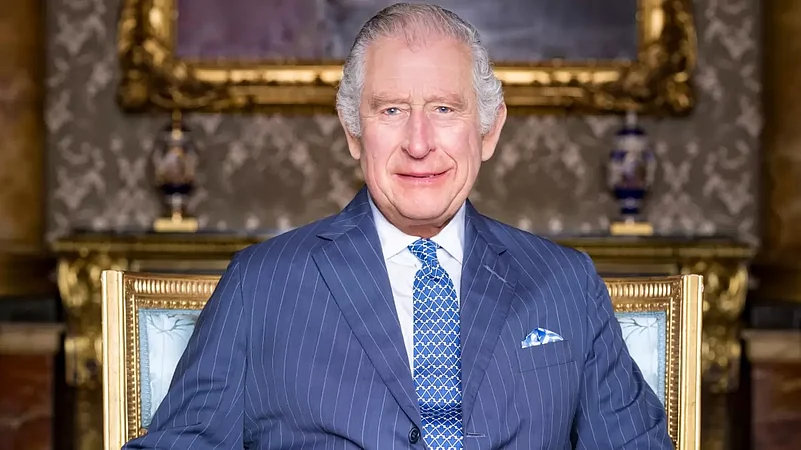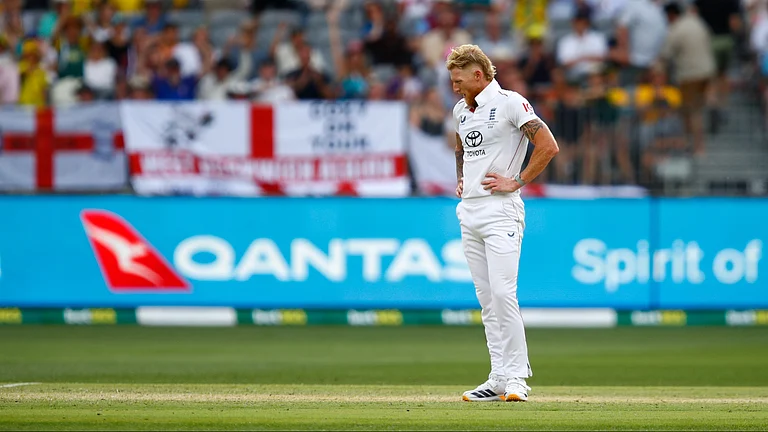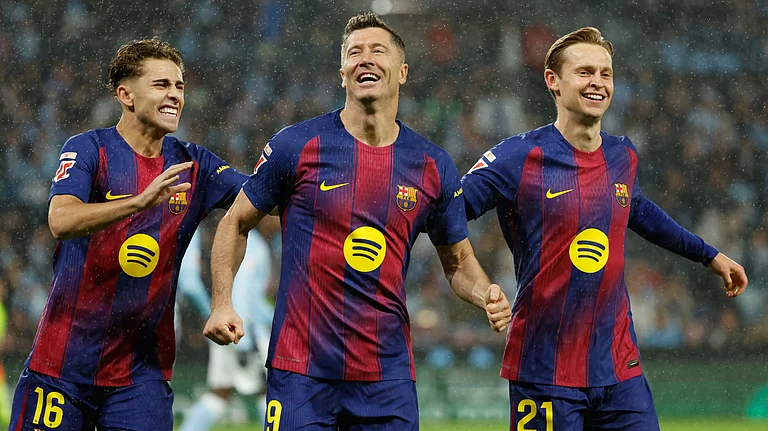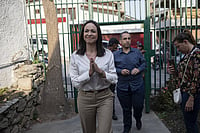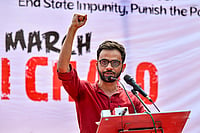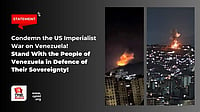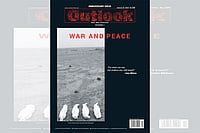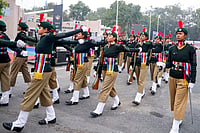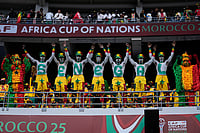The coronation of Charles III as the King of United Kingdom of Great Britain and Northern Ireland will take place on Saturday.
At 73, Charles is the oldest to assume the British throne. He succeeds his late mother Queen Elizabeth II, the longest reigning British monarch.
While Elizabeth II was the face of the monarchy for over seven decades, Charles now has the job of ushering it into the new age where its several aspects ranging from the very idea of the monarchy to the conduct of the Royals are open to scruitiny.
Charles, however, is not a stranger to public scruitiny. As heir to his mother, he had his fair share of public spotlight over the fallout of his marriage with late Princess Diana. That episode and his second marriage to Camilla, now the Queen Consort, were key moments of British society that was marching from imperial days to a new age where it had to contend with being a second-rung power and a society adjusting between old-world regalia and modern beliefs.
Outlook's Rakhi Bose noted that the late Queen played a role in normalising divorce in the British society which held stigma against it.
"Though herself a champion of stoic family values, with time Queen Elizabeth’s reign nevertheless saw the monarchy take begrudging yet affirmative steps toward abolishing social ills like stigma against divorce, which was not permitted by the Church at the time...Reports suggest that the Queen made every effort to reach an amicable solution but later allowed the divorce of Charles and Diana against the Church rules, a first in the monarchy. She also allowed the marriage of Charles and Camilla, also a divorcee, after Diana’s death," noted Bose.
Now in the absence of the towering figure of Elizabeth II, Charles, who has never been a stranger to controversies or spotlight that Royals prefer to stay away from, has the task cut out for him to steer the monarchy ahead.
Here we trace the life, major milestones, and the controversies of King Charles III of the United Kingdom of Great Britain and Northern Ireland.
Early life and education
King Charles III was born on November 14, 1948 at Buckingham Palace in London. He is the eldest child of late Queen Elizabeth and Prince Philips.
Prior to his mother's death in September 2022, Charles was the longest-serving British monarch-in-waiting. He was referred to as Prince Charles then.
In 1952, Charles became the heir to the British throne at the age of four as his mother Elizabeth II was crowned Queen.
In 1958, Charles became the Prince of Wales, a title usually given to heirs to the throne.
Initially, Charles was educated privately. He was taught privately at London, Hampshire, and Scotland.
During 1957-67, Charles received formal schooling, first Hill House prep school in Knightsbridge and then at Gordonstoun in Aberdeenshire.
During 1967-70, Charles attended the Trinity College, Cambridge, and received a bachelor's degree. He is the first Royal to have a university degree. He studied anthropology, archaeology and history.
In 1971, Charles began his military service, a tradition among British Royals also followed by his sons William and Harry. He attended Air Force and Naval academies.
"He then attended the Royal Air Force College (becoming an excellent flier) and the Royal Naval College, Dartmouth, and from 1971 to 1976 took a tour of duty with the Royal Navy," notes The Britannica Encyclopaedia.
Military service of King Charles
During 1971-76, Charles served in the British military. He retired with the rank of Commander in 1976.
"He began as a 22-year-old acting sub-lieutenant when he joined an 'accelerated graduates' course at Britannia Royal Naval College in Dartmouth on 15 September 1971. Two months later he was posted to the guided missile destroyer HMS Norfolk, and then to the frigates HMS Minerva and HMS Jupiter...During 1972, the prince worked hard during his training and experienced life at sea during the Cold War," note Forces.net, a British military news website.
It further says, "Some of his experiences included learning the submarine emergency escape drill at HMS Dolphin, sailing with hunter-killer HMS Churchill, studying navigation at HMS Mercury and putting his knowledge to the test aboard minehunter HMS Glasserton...His career took a step up when he became a gunnery officer on HMS Minerva on West Indies patrol...In 1974, the future King qualified as a helicopter pilot, and he flew with 845 Naval Air Squadron from the commando aircraft carrier HMS Hermes. The next challenge he undertook was the endurance and Tarzan courses with the Royal Marines."
The final military assignment of Charles was as the Commanding Officer of Ton-class minesweeper HMS Bronington.
Marriage with Diana, subsequent fallout
The most well-known phase of the life of Charles is his marriage with Diana and its subsequent fallout.
In 1979, Charles and Diana Spencer met. She also belonged to the British nobility and was known to the younger siblings of Charles.
Diana's parents were Edward John Spencer, Viscount Althorp, and his first wife Frances Ruth Burke Roche, daughter of the 4th Baron Fermoy.
The Britannica says, "Diana was born at Park House, the home that her parents rented on Queen Elizabeth II’s estate at Sandringham and where Diana’s childhood playmates were the queen’s younger sons, Prince Andrew and Prince Edward."
In 1981, Charles and Diana were married. She was 19 and Charles was 31. It was a televised wedding called the 'Wedding of the Century' and was watched by around 750 million people in 74 countries, according to The Insider.
As Charles and Diana toured the world, the popularity of Diana grew, who was now formally called Princess of Wales. The Insider notes that 'Diana Fever' was sweeping across the world as her personality and conduct won her popularity all around.
The Insider notes, "Diana was always eager to meet with people of all ages and backgrounds while traveling and refused to wear gloves when meeting people, which was typically customary for royals. Nearly 100,000 people cheered for Charles and Diana as they drove through the streets of Tokyo in 1986, exemplifying that Diana's popularity reached far beyond the borders of the United Kingdom."
Later, Diana was also famously and fondly called 'the People's Princess'.
By 1986, however, the marriage of Charles and Diana had broke down, according to Guardian. Though it was not yet known publicly.
In 1987, first public developments around their decade-long episode emerged. Diana's bodyguard Barry Mannakee was transferred out and it led to conversations that the two were having an affair.
"After Diana's bodyguard was transferred to another role due to rumors the two were having a romantic relationship, trouble between the royal couple became more public," notes The Insider.
In 1986, Charles is also said to have started an affair with Camilla, who he had dated earlier but had broke up. She would go on to be his second wife later in life.
In 1992, the affair of Charles and Camilla became public with media reports. It began to be called 'Camillagate'. The same year, Andrew Morton’s book Diana: Her True Story said Charles had a long-term affair with Camilla, according to AP. Insider notes that an intimate and sexual conversation of Charles and Camila was also leaked publicly.
"An 'intimate transcript of a 1989 phone call' between Charles and Camilla was released to the public in November 1992. The call was scandalous and sexual in nature, with Charles reportedly joking he would like to be transformed into a pair of [Camila] Parker Bowles' 'knickers' or her tampon," reported Insider.
In 1992, Charles and Diana get separated but continue to carry out Royal duties separately.
In 1994, Charles publicly admitted he had an affair with Camilla. Diana wore her famous 'revenge dress' to a party that has since become iconic.
In 1995, Diana too admitted to an affair with her riding instructor in an interview.
In 1996, Charles and Diana get divorced after four years of separation and 15 years of formal marriage.
During 1996-97, Diana was linked to a number of male partners. They included surgeon Hasnat Ahmad Khan, singer Bryan Adams, and, Dodi Fayed, the son of an Egyptian Billionaire.
In 1997, Diana died in a car accident in Paris, France. She was with Dodi Fayed in the car, who also died in the accident. There was an immense outpouring of grief and sympathy for Diana following her death.
In 2005, Charles and Camilla got married. Camilla had also divorced her husband earlier. When Charles became King, Camilla became Queen Consort.
Charles lifelong environmentalism
While most people outside of the United Kingdom know Charles primarily from the public fallout of his marriage with Diana, he has also been champion of environmental causes.
For decades, Charles has also been a critic of modern architecture.
The Britannica says, "Arguably, the issue that has remained closest to Charles’s heart is his concern for the environment, which dates to at least 1970, when he delivered a speech on the 'horrifying effects' of all forms of pollution and called attention to the threat posed by 'indestructible plastic containers'."
Through his charities and public engagements, Charles has been a leading voice on global warming and sustainability over the decades.
The Britannica also notes Charles as "outspoken critic of modern architecture".
"He expressed his views on the topic in A Vision of Britain (1989). In 1992 he founded the Prince of Wales’s Institute of Architecture, which later evolved into the BRE Trust, an organization involved with urban regeneration and development projects," notes Britannica.
Following his decades of environmental activism, some quarters wonder whether his reign would be one of an interventionist where he would not be a figurehead but would continue to be vocal on issues. So far, Charles has avoided any controversy like that.
In the United Kingdom, the monarch is a figurehead. There are regular formal meetings between the Prime Minister and the monarch but the monarch does not play a public political role. There is a sof power element along with a sense of permanency that comes with the monarch. How Charles reconciles to this role is yet to be seen in full.






